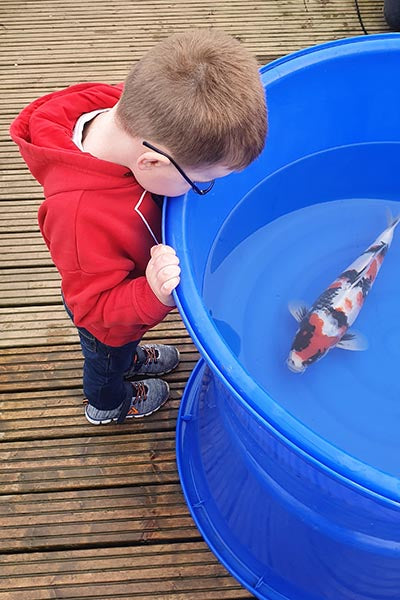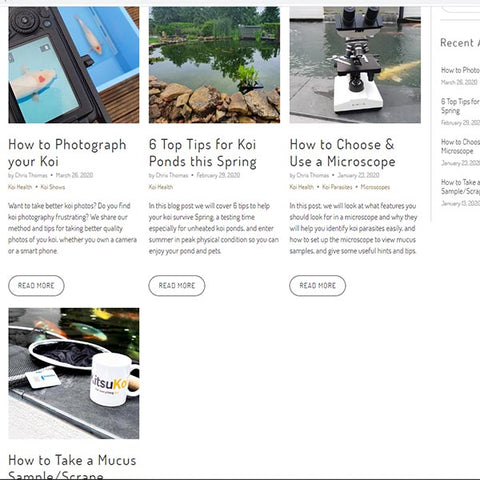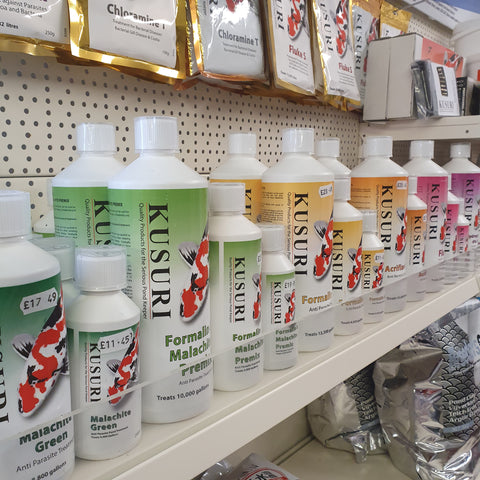Your Cart is Empty
by Graham Thomas March 26, 2020 5 min read 1 Comment

It’s pretty simple to take a snapshot of your fish (or anything else really) these days as almost everyone has a smart phone. For a lot of subjects, smart phones can even be used to take professional images that can appear in print or online. However, taking photographs of koi is a little more challenging than that Instagram worthy food shot – koi move fast, and the reflections on the water are tricky to work around even with professional equipment and experience.

|
|
This could be a lot better!
|
You would want clear photos of your koi if you are trying to advertise them for sale, keep records of growth and development, learn about the bloodline/parents of your koi, online benching for koi shows, or to enter your prized pets in to photo shows. Taking a little time to present the koi well will help to better evaluate body shape, pattern, and skin quality.
 |
|
Better!
|
In this blog post we will cover equipment, koi handling, and the set up to get better photos. This guide is NOT a guide on ‘photography’, so I will try and avoid technical photography terms (the truth is I only use one setting!). I will use a digital SLR camera and flash, which will give best results, however a lot of the techniques will aid smart phone photographers also.
To take useful photos of koi, you will need some basic equipment that most koi keepers will already own, plus I will list some items that make the process easier and can give better photo results.
 |
 |
 |
| A selection of koi bowls | Waterproof Koi Sock |
Kusuri Masuizai Koi Sedate
|
In photography, everything is up for interpretation, but when photographing koi for record keeping, or showing, then there is a perfect shot you want to capture. The photo should be taken with the koi facing the camera, as straight as possible, with the pectoral fins out. To prevent obscuring any details, you want the water to be free of particles, calm without ripples, and good lighting/shade to prevent reflections. Let’s look at the process we follow when taking photos for our website and customers. I’m not claiming to be a pro, nor can I repeat my occasional successes everytime, there are too many jobs to do for me to strive for perfection for the purpose of my photos, but I hope this guide helps you improve your pictures.
Top Tips
 |
|
The perfect pose - hit that shutter button!
|
I hope this guide will improve your koi photography, and hopefully helps you do better in photo shows, or keep better track of your pets growth and development.
If you need any equipment to help you take better photos of your koi, we have a great selection of bowls and socks to suit all sizes of koi, as well as Kusuri Masuizai Koi Sedate.
Taking photographic records at the start of Spring and end of Autumn provides a great opportunity to check your fish for parasites or any damage. Please check our other blog posts for information on taking mucus samples and examining them under a microscope.

If you do need to treat your koi for parasites or damage, we keep a range of Koi & Pond Treatments in store and online from Kusuri, NT Labs, Aqua Source, Vetark, Lincolnshire Fish Health and more.

Graham has been keeping koi for over 25 years, and dealing in koi for 15 years. Travelling to Japan to select new stocks is the favourite aspect of the business, closely followed by being on the tools pond building.
Comments will be approved before showing up.
John boyce
April 07, 2020
Great advice 👍👍👍